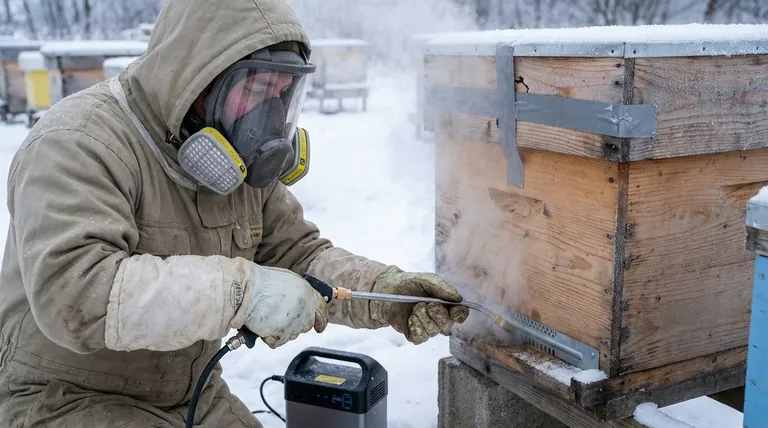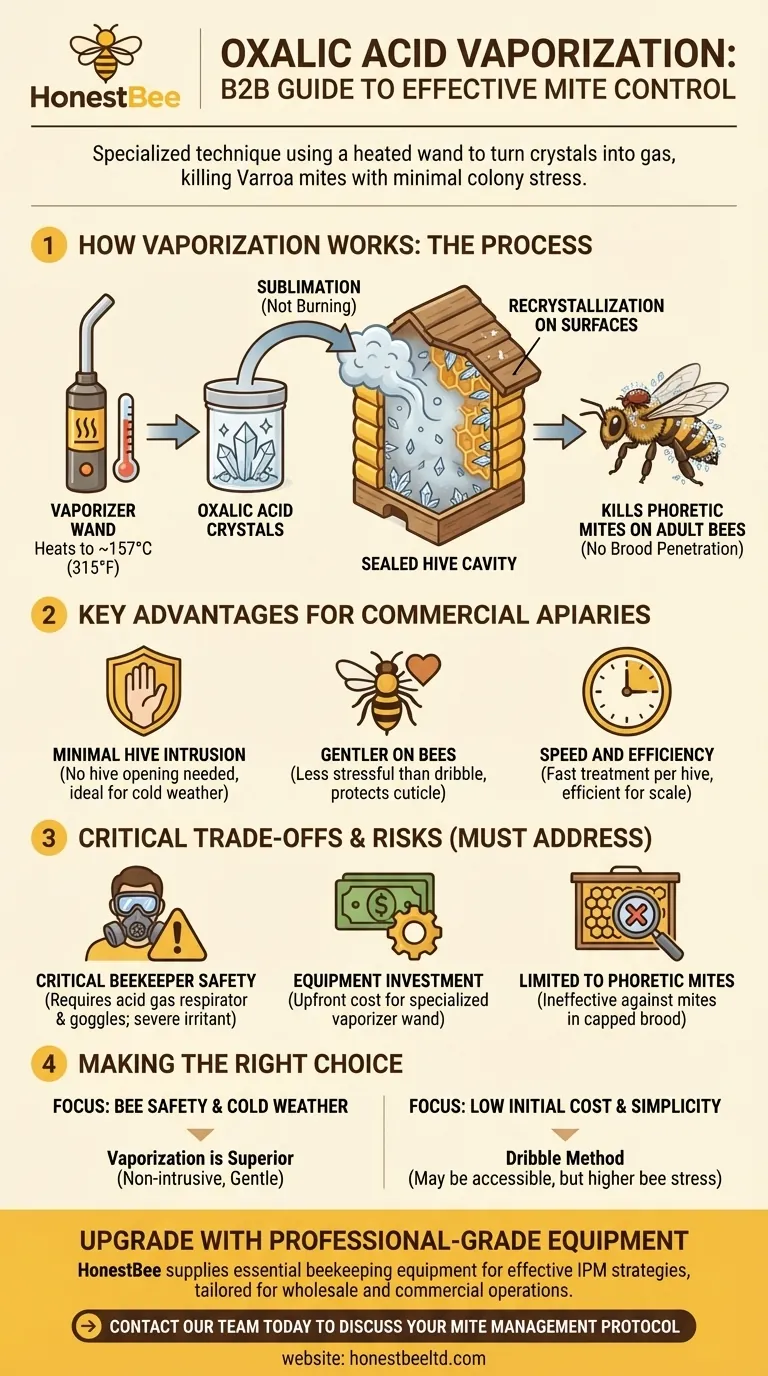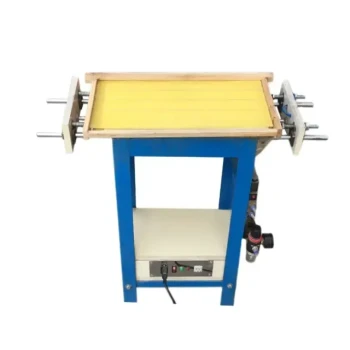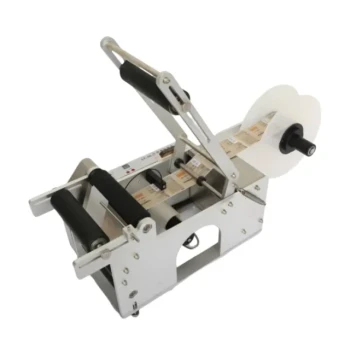The oxalic acid vaporization method is a highly effective technique for treating Varroa mites in a honey bee colony. It involves using a specialized heating device, or "wand," to heat oxalic acid dihydrate crystals until they turn directly into a gas. This vapor is contained within the sealed hive, where it later recrystallizes on all internal surfaces, killing the exposed mites with minimal stress to the bees.
The core principle of vaporization is to fumigate the hive with a fine crystal dust of oxalic acid. This method is exceptionally gentle on bees and ideal for cold-weather treatments, but it demands a significant investment in specialized equipment and an unwavering commitment to personal respiratory safety.

How Vaporization Works: The Core Process
The effectiveness of vaporization lies in its ability to distribute oxalic acid throughout the hive without direct liquid application. The process relies on a simple principle of physics.
Sublimation, Not Burning
The vaporizer wand heats the oxalic acid crystals to approximately 157° C (315° F). At this temperature, the solid crystals do not melt or burn but undergo sublimation, transforming directly into a gaseous vapor.
Filling the Hive Environment
This hot vapor is lighter than air and quickly fills the entire hive cavity. To ensure its effectiveness, the hive is temporarily sealed at the entrance and any other large openings to contain the vapor for a set period.
Recrystallization on Surfaces
As the vapor cools, it reverts to its solid state, forming a micro-fine layer of sharp, spiky oxalic acid crystals. These crystals coat everything inside the hive: the bees, the comb, and the hive walls.
The Effect on Varroa Mites
Varroa mites that are riding on the bodies of adult bees (phoretic mites) come into contact with these microscopic crystals. The crystals are believed to damage the mites' mouthparts or empodium (the adhesive pad on their feet), leading to their death.
Key Advantages of the Vaporization Method
Beekeepers often choose vaporization over other methods for several distinct reasons, particularly related to colony health and treatment timing.
Minimal Hive Intrusion
Because the wand is inserted through the hive entrance, there is no need to open the hive to administer the treatment. This is a significant advantage in late fall or winter when opening a hive would chill the brood and stress the colony's winter cluster.
Gentler on Bees
Unlike the dribble method, which uses a sugar-water solution that can damage a bee's protective cuticle, vaporization is much gentler on the bees themselves. It is widely considered the least stressful application method for the colony.
Speed and Efficiency
Once the equipment is heated and the process is established, treating an individual hive can be accomplished in just a few minutes, making it an efficient method for managing multiple colonies.
Understanding the Trade-offs and Risks
While effective, vaporization is not without its challenges and requires a clear understanding of the risks involved.
Critical Beekeeper Safety
This is the most significant drawback. Oxalic acid vapor is a severe respiratory and eye irritant that can cause serious, permanent damage. Using a simple dust mask (like an N95) is completely insufficient.
A properly rated acid gas respirator, along with full-wrap safety goggles and gloves, is non-negotiable safety equipment for this procedure. You must always treat from upwind of the hive to avoid any leaking vapor.
Equipment Investment
This method requires a specialized tool—the vaporizer wand. These wands vary in price and durability, representing an upfront cost that other methods, like dribbling, do not have.
Limited to Phoretic Mites
Like all oxalic acid treatments, vaporization only kills Varroa mites on the bodies of adult bees. It does not penetrate capped brood, where the majority of mites reproduce. Therefore, its effectiveness is highest during periods when the colony is naturally broodless.
Making the Right Choice for Your Apiary
Choosing your Varroa treatment method depends on your climate, budget, and commitment to safety protocols.
- If your primary focus is bee safety and cold-weather treatment: Vaporization is the superior choice due to its non-intrusive nature and gentleness on the colony.
- If your primary focus is low initial cost and simplicity: The dribble method may be more accessible, but it comes with greater stress on the bees and is not suitable for cold conditions.
- If you are unwilling to invest in and properly use essential safety gear: You must not use the vaporization method; the personal health risks are far too significant.
By understanding the principles and strict safety protocols of vaporization, you can effectively manage Varroa mites while maximizing the health and well-being of your colonies.
Summary Table:
| Aspect | Key Detail |
|---|---|
| Process | Heating oxalic acid crystals to create a gas that fills the hive and recrystallizes on surfaces. |
| Primary Advantage | Minimal hive intrusion; gentler on bees than dribble methods, especially in cold weather. |
| Key Consideration | Requires significant investment in a vaporizer wand and strict use of an acid gas respirator for safety. |
| Effectiveness | Kills phoretic mites on adult bees but does not penetrate capped brood cells. |
Upgrade Your Apiary's Varroa Mite Control with Professional-Grade Equipment
For commercial apiaries and beekeeping equipment distributors, effective and bee-safe mite management is critical for colony health and productivity. The oxalic acid vaporization method offers a superior, low-stress solution, but it requires reliable, durable equipment to be implemented safely and at scale.
HONESTBEE supplies the essential beekeeping supplies and equipment you need to integrate this effective treatment into your IPM strategy. We provide wholesale-focused solutions to help you protect your investment and ensure the well-being of your colonies.
Ready to enhance your mite management protocol? Contact our team today to discuss our range of professional beekeeping equipment and supplies tailored for commercial operations.
Visual Guide

Related Products
- Adjustable Formic and Acetic Acid Dispenser for Bee Mite Treatment
- HONESTBEE Advanced Ergonomic Stainless Steel Hive Tool for Beekeeping
- Economy Small Scale Honey Dryer Dehumidifier Thickening Machine
- High Quality Honey Dehumidifier Dryer Thickening Machine for Beekeeping
- Professional Pneumatic Wire Embedder for Beehive Frames
People Also Ask
- What are some common predators and pests that target beehives? Protect Your Hives from Bears, Mites, and Beetles
- How can beekeepers ensure their hives survive the winter? A Guide to Colony Survival
- What should beekeepers do to manage varroa mites effectively? Adopt a Proactive Monitoring Strategy
- How do Varroa mites spread between honey bee colonies? Stop Mite Transmission in Your Apiary
- What are phoretic mites? A Beekeeper's Guide to Monitoring Varroa Infestation



















